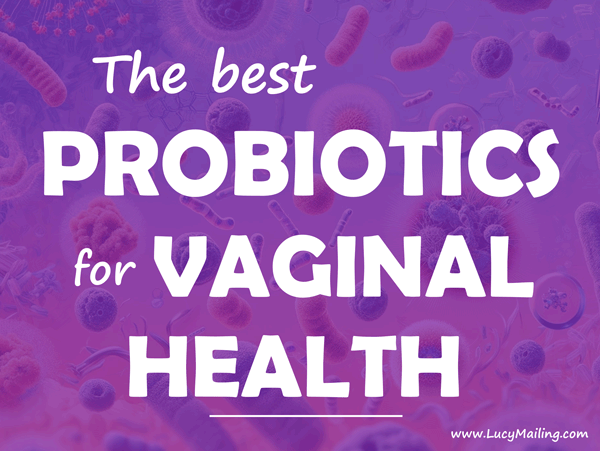While Lactobacilli make up a relatively tiny percentage of a healthy gut microbiome, they are highly prevalent in the vagina and crucial for maintaining vaginal health. Several strains of Lactobacilli have been studied as probiotics for the treatment and prevention of vaginal yeast infections, bacterial vaginosis, and more. In this article, I cover the most evidence-based strains and products.
Key species in the vaginal microbiome
Four species make up the bulk of Lactobacilli in the vaginal microbiome – L. iners, L. crispatus, L. gasseri, and L. jensenii. However, other species like L. acidophilus, L. fermentum, and L. rhamnosus, also contribute. These Lactobacilli, along with other lactic-acid-producing bacteria like Pediococcus and Streptococcus, create a protective barrier by adhering to the vaginal wall, producing antimicrobial substances like hydrogen peroxide and bacteriocins, and maintaining an acidic environment through lactic acid production.
Compared to the gut microbiota, a healthy vaginal microbiota has a relatively low diversity and is heavily dominated by these lactic acid bacteria.
Vaginal dysbiosis and its consequences
Imbalances in the vaginal microbiota can lead to conditions like bacterial vaginosis (BV), characterized by an overgrowth of other bacteria like Gardnerella and Prevotella species, and vulvovaginal candidiasis (VVC), a fungal infection predominantly caused by the yeast Candida albicans.
Vaginal dysbiosis can also increase susceptibility to urinary tract infections, reduce fertility, and pose risks during pregnancy.
Probiotic strains with the most evidence for vaginal health
Certain strains of Lactobacilli, given as probiotics, can help support vaginal health and prevent or treat these conditions. The most well-studied strains for vaginal health are:
L. reuteri RC-14 and L. rhamnosus GR-1. This two-strain combination is one of the most effective probiotics for reducing recurrences of bacterial vaginosis and urinary tract infections. One placebo-controlled trial also found this strain combination effective at reducing Group B Streptococcus colonization in pregnant women. Another study found these strains improved VVC outcomes in women treated with antifungals.
These two strains are available in the products Jarrow Fem-Dophilus (available as 1 billion CFU or 5 billion CFU/capsule) or Metagenics Ultra Flora Women’s Probiotic (2 billion CFU/capsule). While no study has directly compared different doses in humans, most studies that found benefits used a total dose of 2-5 billion CFU/day. Thus, a reasonable approach might be to use a higher dose for the initial treatment of BV or VVC, followed by a lower dose for ongoing prevention.
Lactobacillus crispatus LbV 88, Lactobacillus jensenii LbV 116, Lacbacillus gasseri LbV 150N, and Lactobacillus rhamnnosus LbV 96. This four-strain combination has been studied in a total of three clinical trials. One found a potential benefit of a yogurt drink containing these four strains for women with bacterial vaginosis being treated with antibiotics. Another reported that it positively modulated the vaginal microbiota in women with breast cancer undergoing chemotherapy. A third found that it reduced gastrointestinal and vaginal symptoms and the incidence of preeclampsia in pregnant women with herpesvirus infection. This combination can be found in the product Jarro-Dophilus Prenatal (previously Jarro-Dophilus Women), along with an evidence-based strain of B. infantis.
The Australian probiotic LifeSpace Women’s Microflora Probiotic combines three of these strains - LBV88, LBV 96, and LbV 150N (3.3 billion CFU/capsule) - with the two strains above - GR-1 and RC-14 (2 billion CFU/capsule). It also has one additional strain of L. plantarum with limited evidence in humans (only one open-label study in women with VVC treated with antifungals).
Lactobacillus crispatus M247: In a single, open-label, uncontrolled study, this strain was well tolerated and shown to reduce human papillomavirus positivity and shift the vaginal microbiome towards a healthier state. In vitro and in vivo studies suggest that this strain can upregulate PPAR-gamma expression in the colonic mucosa via hydrogen peroxide production and showed protective effects in a mouse model of colitis. This strain is found in the Italian probiotic Crispact.
Summary & takeaways
While this article discusses the role of probiotics, it’s important to note that numerous factors influence vaginal health. Estrogen levels are a key regulator of the vaginal microbiome, influencing levels of Lactobacilli and Candida albicans. Gut health status can also influence vaginal health, as microbes can translocate from the rectum to the vagina, and the gut may serve as a reservoir for both potentially pathogenic bacteria and beneficial strains of Lactobacilli.
Probiotics are also not the only source of lactic acid bacteria. Lactobacilli are highly enriched in fermented dairy products and lacto-fermented vegetables like sauerkraut and kimchi. They are also present in and on many fruits and vegetables, albeit at lower abundance. For most people, consuming food sources of Lactobacilli as part of an overall healthy diet may be sufficient to support optimal vaginal health.
That said, it could be worth trying the probiotics mentioned here if you are struggling with BV, VVC, or frequent urinary tract infections despite a healthy diet and lifestyle. The strongest choice seems to be Jarrow-Fem Dophilus (5 billion CFU initially, followed by a smaller maintenance dose) though I may occasionally suggest others if symptoms do not resolve.
Do you have frequent concerns with vaginal health? Have you tried any of these probiotics? Share your thoughts or experiences in the comments below!
Note: I have no financial affiliations with the products mentioned here. If you find this useful, you can support my work through a paid subscription to my SubStack or check out my 1-on-1 consultations. Thanks for reading!





Hi Lucy. When is the next Q & A so that we can submit our questions, please? Thanks!